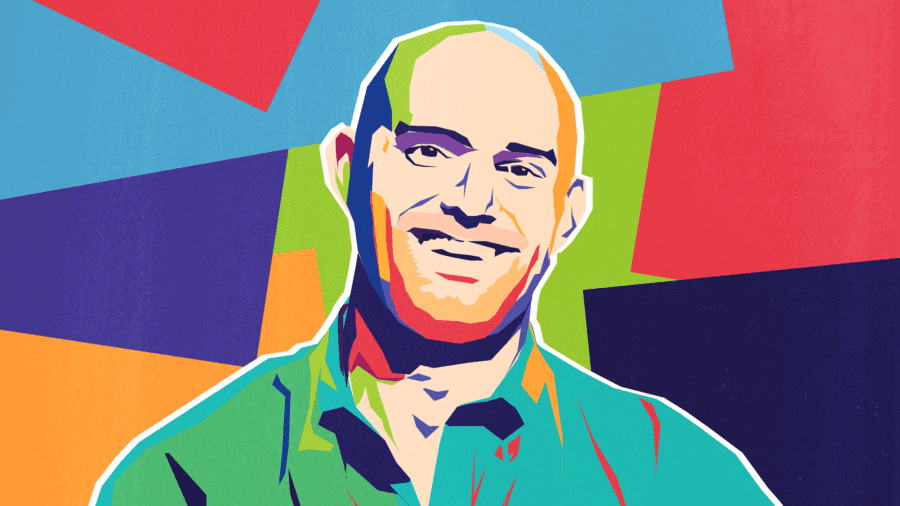
How to Turn a Narcissistic Wound into Wisdom According to Psychologist Dr. Ramani Durvasula
Relationships are hard. But a relationship with a narcissist is next to impossible.
What do you do if the narcissist you know is a family member and you can’t remove them from your life? Is it possible to heal from wounds inflicted by a narcissist?
Navigating a relationship with a narcissist can feel like a losing battle, and healing narcissistic wounds can feel like a task that will never end. But there is hope. This article will outline what a narcissist is and what makes them tick, three strategies for navigating a relationship with a narcissist, and three steps to healing and moving past narcissistic wounds.
Knowing the Narcissist
If you think you know someone who is a narcissist, you’re not alone.
Dr. Ramani Durvasula estimates that 20% of people have narcissistic tendencies — that’s one narcissist for every five people! But how can you be sure the person you’re spending time with is truly a narcissist?
Narcissistic people are very sensitive to criticism. Instead of taking responsibility for their actions or mistakes, narcissists chronically blame other people or situations.
Narcissism is like selfishness on steroids. It’s characterized by an inflated sense of self-importance, excessive need for admiration, and often a lack of empathy for others.
Narcissists tend to be very charismatic individuals. It is not uncommon for them to come across as empathetic. However, Dr. Ramani Durvasula cautions that a narcissist’s empathy will only extend as far as their goal. If being aware of your feelings helps them get where they want to go, that’s what they will do until they reach their destination.
Dr. Ramani Durvasula’s advice on being in a narcissistic relationship is to leave. Studies have shown that most healing related to a narcissistic relationship happens with zero contact; however, for some people, that may not be an option. Throughout the rest of this article, we will share strategies for being in a relationship with a narcissist and healing.
How to Navigate a Relationship With a Narcissist
Have you ever heard of a hurricane party?
In certain parts of Florida, when a hurricane is imminent, people board up their houses, stock up on drinks, and hunker down with whichever friend has the safest house. They can’t stop the hurricane from happening, so they make peace with it and make the most of it.
If your life requires you to stay in a relationship with a narcissist, your new anthem must become, “accept what is and make the most of it.”
Narcissists, generally speaking, don’t change. Instead, you will have to adopt three new ways of living.
#1: Radical Acceptance
Have you ever run through a torrential downpour to your car even though you didn’t want to get wet because that was the only way to your car?
If so, you practiced radical acceptance, embraced reality, and received its impact.
In relationships, this is often embodied by an unoffendable person who doesn’t take things personally. It’s almost the exact opposite of narcissistic behavior, and it’s your primary defense when in a relationship with a narcissist.
Instead of hoping for or trying to change the narcissist in your life, you accept them radically without taking offense. This gives you inner power in three areas:
- You can work on healing yourself. Radical acceptance embraces the fact that a narcissist rarely, if ever, changes, which means you can stop waiting for them to apologize for the things they did and said that hurt you.
- You can set boundaries and habits. While a narcissist may never change, you can. You can create new rhythms and ways of communicating that protect and serve you.
- You can forgive them. It’s been said more than once — because it’s true — that by carrying unforgiveness, you hurt yourself, not the other person. Radical acceptance acknowledges that a narcissist is broken in the way that they relate to and treat others.

The Greatness Mindset
Learn the secrets of some of the greatest minds in the world. Unlock the power of your mind and live your best life today.
Learn More#2: D.E.E.P.
Do you know what you’re supposed to do if you swim in the ocean and get pummeled by a wave?
Don’t fight it. Why? Because clawing at wet sand and frothy waves will waste valuable energy — maybe even keep you underwater longer. You’re likely to surface naturally if you relax.
That’s easy to say but extremely difficult to do. Being tumbled by a wave has been explained as one of the most disorienting experiences. And yet, relaxing and letting the wave eventually bring you back up is the secret to surfacing.
Dr. Ramani Durvasula gives similar advice to people in relationships with narcissists. She uses the acronym D.E.E.P.:
- Don’t Defend
- Don’t Engage
- Don’t Explain
- Don’t Personalize
Narcissists are aggressive to the bitter end, fueled by a pursuit of power. You most likely can’t beat them at their own game, but by mobilizing D.E.E.P., you steal the oxygen from their “fire.”
#3: Pick Your Battles
Have you seen the Instagram reel of a mom filming her yard covered in clover, saying it was the best decision ever?
One can assume one of the top reasons a yard of clover was the best decision ever is her yard is ALWAYS green! (Not to mention her child delightedly crawling through the green clover.) She picked her battles. Her house might not be clean, but her yard is green. Her child might not like his toys, but he likes crawling through the clover.
When you are in a narcissistic relationship, you must pick your battles. Chances are, you’re going to “win” very few arguments, so if you choose to engage, make sure it’s an issue you’re willing to go all out for.
Picking your battles, according to Dr. Ramani Durvasula, is something you should do preemptively. Don’t wait for the moment to arrive and then decide it’s a battle you want to jump on. Decide ahead of time. This should include three steps:
- Pick the issue. This should not be a vague moving target; it should be consistent and specific.
- Define your request. Again, this should be specific and consistent any time this issue comes up. Write it out ahead of time, so you know exactly what to say.
- Predetermine your response. In other words, what will you do if you do not get your way? If your response is to acquiesce, you may never win this battle in the future.
Just because you choose to be in a relationship with a narcissist and embrace radical acceptance does not mean you relinquish your humanity. You are still a person worthy of admiration and respect, and there are still battles worth fighting — you just have to decide which ones those are.
Join In 200 Million+ On The Journey to Greatness
Look for Green Flags in Future Relationships
Have you ever seen moths dancing around a solo light at night?
The moths can’t help themselves — they’re just attracted to the light. If you aren’t careful when healing your wounds inflicted by a narcissist, you will attract narcissists like light attracts moths.
Healing from narcissist wounds usually includes three steps: acknowledgment, self-care, and looking for green flags.
Step #1: Acknowledgement
What happens if you live life without acknowledging an ingrown toenail?
It gets more ingrown, causes pain, and usually leads to infection. By simply acknowledging an ingrown toenail, you can prevent most uncomfortable related experiences. In other words, you can’t fix what you don’t acknowledge.
This is very true for the healing of narcissistic wounds. To heal, you must acknowledge how you hurt. One of the best ways to acknowledge hurt is to give it a name. Do you feel ashamed? Do you feel disrespected? Do you feel unvalued? Do you feel misunderstood? Give your wound a name.
Once you acknowledge the wound, you can treat the wound. Treating the wound may include hiring a therapist, joining a support group, and letting trusted loved ones help you.
After you treat the wound, you can begin healing and living in new ways. This could look like establishing boundaries and implementing new routines.
As you embark on this journey, remember that healing — progress of any kind, really — is not linear. Somedays, you will progress by leaps and bounds, other days, you will feel like you’re inching forward, and some days, you’ll feel like you took three steps back. Healing is slow work, but it is also invaluable work.
Step #2: Self-Care
Have you heard of the plant that grew better than the other because it was next to a cassette playing positive words?
If positive words could do that for a plant, imagine what they could do for you!
People who narcissists have wounded often have a loop of negative words about who they are and what they can accomplish running through their minds. Remember, narcissists are aggressive and driven by a need for power. Those wounded by them usually end up second-guessing themselves, losing touch with their own needs, and having low self-esteem.
Three of the most important things to do when it comes to healing narcissistic wounds are:
- Choose positive self-talk. In the beginning, you may find it helpful to play podcast episodes that promote positive self-talk. Finding your own words for positive self-talk might be challenging if you’ve been engaging with negative self-talk for a long time.
- Unapologetically care for your own needs. This includes establishing boundaries and implementing new routines. You might find it helpful to write out three things you will do to care for yourself each week.
- Be patient with yourself. Remember, healing and progress are not linear. Positive self-talk is a learned habit. Caring for yourself after you’ve spent so much time obsessing over someone else’s needs will take time, but it’s time you won’t regret investing.
Step #3: Look For Green Flags
Have you ever seen someone shopping for eggs open the carton?
They’re making sure the eggs aren’t cracked. In other words, they’re looking for green flags that the eggs are safe for purchasing and use.
One of the most impactful forms of healing from narcissistic wounds is moving on and believing that you can still find and experience healthy, life-giving relationships. To do that, you will need to look for green flags. When do you usually start to see green flags in a relationship?
According to Dr. Ramani Durvasula, you begin to see green flags in a relationship about the same time you would begin to see red flags.
Five green flags to look for in a relationship:
- Celebrates Your Victories. A narcissist frequently turns someone else’s victory into a pity party of why they haven’t achieved more. A healthy person will rejoice in your win and all your effort to achieve it.
- Receives Criticism. Narcissists are defensive and usually turn criticism into a list of excuses or someone else’s shortcomings. A safe person may provide additional information, but they will receive critique and try to improve.
- Takes Personal Responsibility. Narcissistic behavior passes the blame to someone else — they are “never” at fault. Healthy behavior accepts responsibility for their part.
- Shares Attention. A narcissist wants the show to always be about themselves. A healthy person allows time for other people to be the center of attention.
- Serves You. Narcissists expect others to continually go out of their way to serve them. Safe people serve others; they allow others to serve them, too, but are intentional to keep the exchange mutual.
Dr. Ramani Durvasula pointed out that healthy relationships should not always feel like you have to pull teeth. Will they be challenging at times and require uncomfortable conversations? Yes. But, generally speaking, a healthy relationship should be enjoyable and feel like it is working.
It’s Time to Experience a Life-Giving Relationship
Staying in a relationship with a narcissist is hard work. Healing and moving on from a relationship with a narcissist is also hard work. But it is possible work — work that will powerfully transform your life for the better!
Don’t be afraid to take baby steps. Get someone in your corner who can understand and support you, whether a therapist or a trusted friend. Remember, 20% of people exhibit narcissistic behavior. You’re not the only one navigating healing or a relationship with a narcissist.
You are not alone, and you are very capable.
Greatness Authors
Greatness Authors is a collection of writers, thinkers, curiosity experts, and students of the world who are committed to bringing you the most up-to-date, impactful, and inspiring information surrounding Greatness topics.

Redefining Poetry: How Instagram Sensation Rupi Kaur Showed That Poetry Is for Everyone

The 7 Best Vitamins to Naturally Promote Better, Uninterrupted Sleep According to Shawn Stevenson

The Science of Forming Healthy Habits & Letting Go of Bad Ones, According to Author James Clear

9 Signs You Have Imposter Syndrome at Work and How to Overcome Performance Insecurity

Olympian Yusra Mardini’s Incredible Story of Resilience, Rescue, and Refugee Rights










